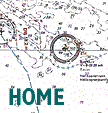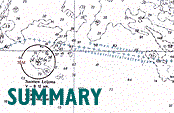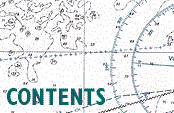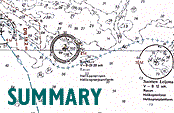 |
13.2.7 The evacuation
Shortly before the start of the accident, most passengers were in their cabins. The major part of the crew were off duty, some in bed and others together in the messrooms or in cabins on decks 7 and 8.
 Passengers were moving about in the foyer areas, passageways, corridors and staircases. A few remaining passengers and some crew members were in the Night Club, and in the Pub Admiral there were 30 to 60 people. Some passengers were resting or sleeping in the lounges and in the café. A limited number were resting in other public areas, passageways and staircases. Passengers were moving about in the foyer areas, passageways, corridors and staircases. A few remaining passengers and some crew members were in the Night Club, and in the Pub Admiral there were 30 to 60 people. Some passengers were resting or sleeping in the lounges and in the café. A limited number were resting in other public areas, passageways and staircases.
 Some passengers had left their cabins at an early stage due to the motion of the ship and the noise. As the list developed, passengers had difficulties in getting out from their cabins due to the furniture and luggage which had slid against the doors. The list made it increasingly difficult to move inside the vessel and to reach open decks. First people tried to help each other, for instance by forming human chains, but soon it became impossible due to the increasing list. Some passengers had left their cabins at an early stage due to the motion of the ship and the noise. As the list developed, passengers had difficulties in getting out from their cabins due to the furniture and luggage which had slid against the doors. The list made it increasingly difficult to move inside the vessel and to reach open decks. First people tried to help each other, for instance by forming human chains, but soon it became impossible due to the increasing list.
 At about 0120 hrs, i.e. five minutes after the list developed, a weak female voice was heard over the public address system calling in Estonian “Häire, häire, laeval on häire” (Estonian for: “Alarm, alarm, there is alarm on the ship”). Shortly thereafter the second officer A called the alarm Mr Skylight to number one and two. About two minutes later the general international life boat alarm was initiated. At about 0120 hrs, i.e. five minutes after the list developed, a weak female voice was heard over the public address system calling in Estonian “Häire, häire, laeval on häire” (Estonian for: “Alarm, alarm, there is alarm on the ship”). Shortly thereafter the second officer A called the alarm Mr Skylight to number one and two. About two minutes later the general international life boat alarm was initiated.
 Many of those who succeeded in reaching open decks had difficulties in putting on lifejackets properly. People hung on to the railings and climbed onto the side of the vessel when she was lying nearly on her side. Waves washed some people into the sea and others started jumping into the sea at about half past one o'clock. Most had difficulties in gaining the rafts, tens of which were floating around the vessel. Few people were able to board a raft on the side of the vessel. Figure 13.4 illustrates the development of the list as experienced on the open deck near the funnel. Many of those who succeeded in reaching open decks had difficulties in putting on lifejackets properly. People hung on to the railings and climbed onto the side of the vessel when she was lying nearly on her side. Waves washed some people into the sea and others started jumping into the sea at about half past one o'clock. Most had difficulties in gaining the rafts, tens of which were floating around the vessel. Few people were able to board a raft on the side of the vessel. Figure 13.4 illustrates the development of the list as experienced on the open deck near the funnel.
Figure 13.4 Development of the list as experienced on the open deck.
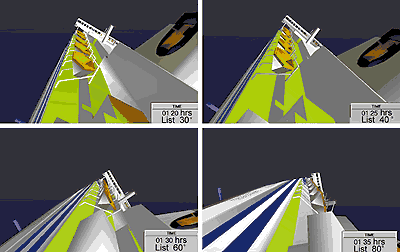
The time available for evacuation to open deck was between 10 and 20 minutes. During this period at least 237 people escaped from the vessel. The evacuation is further analysed in Chapter 16.
|
 |
 |
When the ESTONIA was at sea the bridge-watch always consisted of two officers and one AB seaman. The duties of the AB seaman were to make inspection rounds in the vessel and to serve as an additional look-out. For further details of the working routines see 4.3.
 When the officers on the bridge received the AB seaman's report of the metallic bang shortly before one o'clock, second officer B ordered him to stay in the area and investigate the origin of the sound. After about five minutes he reported back that he had found nothing abnormal and the sound was not repeated. The AB seaman was ordered to continue his watch round. When the officers on the bridge received the AB seaman's report of the metallic bang shortly before one o'clock, second officer B ordered him to stay in the area and investigate the origin of the sound. After about five minutes he reported back that he had found nothing abnormal and the sound was not repeated. The AB seaman was ordered to continue his watch round.
 There was a watch change on the bridge at one o'clock when the second officer A and the fourth officer relieved second officer B and the third officer. Normally the ongoing watch arrived at the bridge not later than five minutes prior to the start of its watch, and there are no reasons to believe that the routines were deviated from during this night. There was a watch change on the bridge at one o'clock when the second officer A and the fourth officer relieved second officer B and the third officer. Normally the ongoing watch arrived at the bridge not later than five minutes prior to the start of its watch, and there are no reasons to believe that the routines were deviated from during this night.
 It is considered confirmed that the reported sound from the car deck was known to the officers commencing their watch at one o'clock. The Commission concludes that the information received was not considered alarming since the relieved watch left the bridge as normal. It is considered confirmed that the reported sound from the car deck was known to the officers commencing their watch at one o'clock. The Commission concludes that the information received was not considered alarming since the relieved watch left the bridge as normal.
 When the AB seaman of the watch returned to the bridge from his round about five minutes after one o'clock, he saw the master arrive just ahead of him. The master made general comments on the speed and their probable late arrival in Stockholm. Nothing has been reported to indicate that his visit was other than routine and thus not caused by any concern about the prevailing situation. When the AB seaman of the watch returned to the bridge from his round about five minutes after one o'clock, he saw the master arrive just ahead of him. The master made general comments on the speed and their probable late arrival in Stockholm. Nothing has been reported to indicate that his visit was other than routine and thus not caused by any concern about the prevailing situation.
 Shortly after his arrival at the bridge, the AB seaman was ordered to call the boatswain and accompany him to the car deck to check the bow area and the general situation. Second officer A who gave the order had received a telephone-call, most likely from a crew member, reporting loud noises, believed to be originating from the forward part of the car deck. The boatswain was responsible for operating the ramp and the visor, and the fact that he was called out on his free watch indicates that the situation was considered serious by the officers of the watch. There are no indications that any other action was taken at this stage. Shortly after his arrival at the bridge, the AB seaman was ordered to call the boatswain and accompany him to the car deck to check the bow area and the general situation. Second officer A who gave the order had received a telephone-call, most likely from a crew member, reporting loud noises, believed to be originating from the forward part of the car deck. The boatswain was responsible for operating the ramp and the visor, and the fact that he was called out on his free watch indicates that the situation was considered serious by the officers of the watch. There are no indications that any other action was taken at this stage.
 By this time the bridge had received two reports of sounds. The Commission considers these reports so alarming, that the officers should at least have reduced speed at this stage. By this time the bridge had received two reports of sounds. The Commission considers these reports so alarming, that the officers should at least have reduced speed at this stage.
 The AB seaman has testified that the master was on the bridge when he was sent to the car deck. It is therefore considered most likely that the master was informed of the situation and agreed to the action taken, and that he remained on the bridge during the development of the accident. The AB seaman has testified that the master was on the bridge when he was sent to the car deck. It is therefore considered most likely that the master was informed of the situation and agreed to the action taken, and that he remained on the bridge during the development of the accident.
 The AB seaman never managed to reach the car deck. He waited at the information desk on deck 5 to have the car deck doors unlocked, and at about this time or possibly some minutes earlier, the visor was lost and the ramp pulled open. While he was waiting at the information desk the vessel heeled over and remained with a list of about 15 degrees to starboard. The AB seaman immediately proceeded downwards but was kept back by a stream of passengers escaping from the lower decks, some of them screaming that there was water on deck 1. He turned around and ran towards the boat deck. The whereabouts of the boatswain during this period is not known. The AB seaman never managed to reach the car deck. He waited at the information desk on deck 5 to have the car deck doors unlocked, and at about this time or possibly some minutes earlier, the visor was lost and the ramp pulled open. While he was waiting at the information desk the vessel heeled over and remained with a list of about 15 degrees to starboard. The AB seaman immediately proceeded downwards but was kept back by a stream of passengers escaping from the lower decks, some of them screaming that there was water on deck 1. He turned around and ran towards the boat deck. The whereabouts of the boatswain during this period is not known.
 It is not known what additional information the officers on the bridge received after the AB seaman left the bridge, but it is obvious to the Commission that at least the sound from the visor's collision with the bulbous bow must have been noticed. It is not known what additional information the officers on the bridge received after the AB seaman left the bridge, but it is obvious to the Commission that at least the sound from the visor's collision with the bulbous bow must have been noticed.
 It is evident to the Commission that, because of the list and the sound from the collision the officers on the bridge initiated a reduction of speed and a turn to port. Some minutes later they also closed all watertight doors. It is evident to the Commission that, because of the list and the sound from the collision the officers on the bridge initiated a reduction of speed and a turn to port. Some minutes later they also closed all watertight doors.
 Three to five minutes after the list had developed, the bridge was informed by the AB seaman of the watch, who now was on the boat deck, that passengers were escaping in great numbers from the lower decks screaming that there was water on deck 1. He was again ordered to go down and find out more about the situation. At about the same time the third engineer was ordered by telephone to compensate for the list by pumping ballast. He tried to pump sea-water to the almost full heeling tank but the pump sucked air. The starboard list was at this time about 30 degrees and the officers on the bridge were obviously still seeking more information to understand what was going on. They evidently thought that the adverse conditions could be rectified. Three to five minutes after the list had developed, the bridge was informed by the AB seaman of the watch, who now was on the boat deck, that passengers were escaping in great numbers from the lower decks screaming that there was water on deck 1. He was again ordered to go down and find out more about the situation. At about the same time the third engineer was ordered by telephone to compensate for the list by pumping ballast. He tried to pump sea-water to the almost full heeling tank but the pump sucked air. The starboard list was at this time about 30 degrees and the officers on the bridge were obviously still seeking more information to understand what was going on. They evidently thought that the adverse conditions could be rectified.
 In view of what is known about the rapid course of events and the consequent short time for evacuation, the Commission finds it most unfortunate that the lifeboat alarm was not given until about five minutes after the list developed and when the list was around 35 degrees. Nor was any information given to the passengers over the public address system. In view of what is known about the rapid course of events and the consequent short time for evacuation, the Commission finds it most unfortunate that the lifeboat alarm was not given until about five minutes after the list developed and when the list was around 35 degrees. Nor was any information given to the passengers over the public address system.
 The first Mayday call was received from the ESTONIA at about 0122 hrs, i.e. at about the same time as the lifeboat alarm was given and just after the main engines had stopped. It was a very brief message, containing no other information than the word “Mayday” and the name ESTONIA. The operator has been identified by voice as second officer A on duty. In later radio traffic the operator has been identified as the third officer. A voice heard in the background has been identified as the chief officer's. He and the third officer had come to the bridge obviously alarmed. The first Mayday call was received from the ESTONIA at about 0122 hrs, i.e. at about the same time as the lifeboat alarm was given and just after the main engines had stopped. It was a very brief message, containing no other information than the word “Mayday” and the name ESTONIA. The operator has been identified by voice as second officer A on duty. In later radio traffic the operator has been identified as the third officer. A voice heard in the background has been identified as the chief officer's. He and the third officer had come to the bridge obviously alarmed.
 The time for the distress traffic, from the first call to the last, was eight minutes. Nothing is mentioned to indicate that the officers had any appreciation of what had caused the vessel to develop a list and take in water. The information given was1: “Yes, we have a problem here now, a bad list to starboard. I believe that it was twenty, thirty degrees” followed later on by “We have black out” and, at the end of the distress traffic, “Really bad, it looks really bad here now”. It was about seven minutes before the Estonia gave her position. Due to the very fast development of the accident the late start of the distress traffic did not, however, have much effect on the final outcome of the rescue operation. The distress traffic is reproduced in full in 7.3.3. Figure 13.5 illustrates the development of the list during the distress traffic as experienced on the bridge. The time for the distress traffic, from the first call to the last, was eight minutes. Nothing is mentioned to indicate that the officers had any appreciation of what had caused the vessel to develop a list and take in water. The information given was1: “Yes, we have a problem here now, a bad list to starboard. I believe that it was twenty, thirty degrees” followed later on by “We have black out” and, at the end of the distress traffic, “Really bad, it looks really bad here now”. It was about seven minutes before the Estonia gave her position. Due to the very fast development of the accident the late start of the distress traffic did not, however, have much effect on the final outcome of the rescue operation. The distress traffic is reproduced in full in 7.3.3. Figure 13.5 illustrates the development of the list during the distress traffic as experienced on the bridge.
Figure 13.5 Development of the list as observed on the bridge.
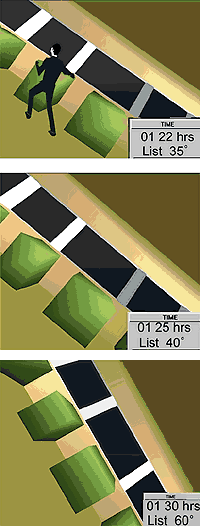
Of the five officers known to have been on the bridge, second officer A and the third officer were seen leaving the bridge in the final stage of the accident. It is believed that the master, the chief officer and the fourth officer remained on the bridge throughout the accident. This assumption is also supported by the fact that three bodies were seen inside the bridge during the diving investigation.
 The two officers that left the bridge were later seen distributing lifejackets and trying to launch lifeboats and rafts. Also the boatswain, who just before the start of the accident was called out to help investigate the sounds on the car deck, was seen on deck 7 taking part in this. The two officers that left the bridge were later seen distributing lifejackets and trying to launch lifeboats and rafts. Also the boatswain, who just before the start of the accident was called out to help investigate the sounds on the car deck, was seen on deck 7 taking part in this.
 It is noteworthy that so little exchange of information seems to have taken place between the bridge and the engine control room during the development of the accident. The third engineer did not inform the bridge about the inflow of water he observed (see 6.2.3). Nor did the officers of the watch call him for an assessment of the situation. If the observation on the monitor had been discussed and evaluated immediately, there could still have been a possibility to influence the development of the accident. It is noteworthy that so little exchange of information seems to have taken place between the bridge and the engine control room during the development of the accident. The third engineer did not inform the bridge about the inflow of water he observed (see 6.2.3). Nor did the officers of the watch call him for an assessment of the situation. If the observation on the monitor had been discussed and evaluated immediately, there could still have been a possibility to influence the development of the accident.
 Nothing indicates that the officers realised that the bow was fully open, although it must have been obvious that the situation was very serious, and that the survival of the vessel was threatened. Nothing indicates that the officers realised that the bow was fully open, although it must have been obvious that the situation was very serious, and that the survival of the vessel was threatened.
 Simulations carried out by the Commission show that a quick reduction of speed and change of heading would have significantly reduced the rate of water ingress. The safest condition for the vessel with the bow open would have been lying beam on to the waves at zero speed. It has also been established that turning the vessel to starboard would not have endangered her stability. The wind pressure would have increased the list by only a few degrees. Thus turning the vessel, with the bow fully open, towards the wind and the high waves was not the best action. On the other hand it must be kept in mind that from the officers' point of view turning the vessel to starboard away from the wind would have exposed the port side to the full force of wind and waves and would have further increased the list and the roll. In this light the decision to turn the vessel to port and into the wind is understandable. Simulations carried out by the Commission show that a quick reduction of speed and change of heading would have significantly reduced the rate of water ingress. The safest condition for the vessel with the bow open would have been lying beam on to the waves at zero speed. It has also been established that turning the vessel to starboard would not have endangered her stability. The wind pressure would have increased the list by only a few degrees. Thus turning the vessel, with the bow fully open, towards the wind and the high waves was not the best action. On the other hand it must be kept in mind that from the officers' point of view turning the vessel to starboard away from the wind would have exposed the port side to the full force of wind and waves and would have further increased the list and the roll. In this light the decision to turn the vessel to port and into the wind is understandable.
 The question of whether a lower speed would possibly have prevented the accident has been reviewed by the Commission. Extensive model tests and numerical simulations have been carried out as summarised in 12.1 and 12.2. The result confirms that a lower speed would have reduced the general loads on the visor and hence the probability of failure. However even at a speed of 10 knots, the loads would still have been close to the strength limits of the visor attachments. The question of whether a lower speed would possibly have prevented the accident has been reviewed by the Commission. Extensive model tests and numerical simulations have been carried out as summarised in 12.1 and 12.2. The result confirms that a lower speed would have reduced the general loads on the visor and hence the probability of failure. However even at a speed of 10 knots, the loads would still have been close to the strength limits of the visor attachments.
 The Commission has also considered whether the officers of the watch had reasons for reducing the speed prior to the start of the accident. The Commission has also considered whether the officers of the watch had reasons for reducing the speed prior to the start of the accident.
 As is the case for many ships, there were no strict procedures or company policy for heavy weather routines on the ESTONIA. The Commission has noted that passengers' comfort, which can easily be observed by the crew, normally seems to be the prime reason for speed reduction for this type of large ferry. In the Commission's experience most masters consider that speed must be reduced for comfort reasons long before it reaches the vessel's strength and safety limits. As is the case for many ships, there were no strict procedures or company policy for heavy weather routines on the ESTONIA. The Commission has noted that passengers' comfort, which can easily be observed by the crew, normally seems to be the prime reason for speed reduction for this type of large ferry. In the Commission's experience most masters consider that speed must be reduced for comfort reasons long before it reaches the vessel's strength and safety limits.
 Although some survivors have described the voyage as being rough before the accident, the officers did not apparently find comfort-related reasons for reducing speed. Although some survivors have described the voyage as being rough before the accident, the officers did not apparently find comfort-related reasons for reducing speed.
 For comparison, numerical analyses and model tests show that in the foremost part of the Estonia vertical accelerations after midnight exceeded by 50 per cent the severe discomfort boundary of International Organisation for Standardisation motion sickness standard. In the restaurant and entertainment areas amidships and in the aft part of the vessel the vertical accelerations were on the other hand significantly below and close to the severe-discomfort boundary, respectively. Considerably higher accelerations than predicted for the ESTONIA have been measured on board passenger vessels in rough weather in many sea areas including the Baltic. Calculations also show that the general condition on board with regard to vertical accelerations and sea-sickness would not have improved much even if speed had been reduced considerably (see 12.4.2). For comparison, numerical analyses and model tests show that in the foremost part of the Estonia vertical accelerations after midnight exceeded by 50 per cent the severe discomfort boundary of International Organisation for Standardisation motion sickness standard. In the restaurant and entertainment areas amidships and in the aft part of the vessel the vertical accelerations were on the other hand significantly below and close to the severe-discomfort boundary, respectively. Considerably higher accelerations than predicted for the ESTONIA have been measured on board passenger vessels in rough weather in many sea areas including the Baltic. Calculations also show that the general condition on board with regard to vertical accelerations and sea-sickness would not have improved much even if speed had been reduced considerably (see 12.4.2).
 Thus it is concluded that the voyage was uncomfortable for many passengers but not exceptional. The vessel was run above or close to the boundaries for comfort criteria. Referring to the above, the officers obviously believed that there was still a good margin to the limits of the bow strength. Thus it is concluded that the voyage was uncomfortable for many passengers but not exceptional. The vessel was run above or close to the boundaries for comfort criteria. Referring to the above, the officers obviously believed that there was still a good margin to the limits of the bow strength.
 The accident points out the need for crews on large ro-ro ferries to have operating instructions and training in manoeuvring vessels in heavy weather. It is a serious shortcoming for the whole shipping industry that there is in general no information on the limits of operability with regard to the ship's strength available on the bridge of large vessels with powerful engines, specially as the size of the vessels makes their motion less perceptible. In the case of the ESTONIA accident, the operating limit with regard to the strength of the visor attachments was significantly lower than the crew had reason to believe. The accident points out the need for crews on large ro-ro ferries to have operating instructions and training in manoeuvring vessels in heavy weather. It is a serious shortcoming for the whole shipping industry that there is in general no information on the limits of operability with regard to the ship's strength available on the bridge of large vessels with powerful engines, specially as the size of the vessels makes their motion less perceptible. In the case of the ESTONIA accident, the operating limit with regard to the strength of the visor attachments was significantly lower than the crew had reason to believe.
|
 |
 |
As described in 3.3.5 indicator lamps on the navigation bridge showed locked or unlocked visor and ramp, respectively. The indicator lamps for the ramp were controlled from the locking devices in such a way that all devices had to be in the position ordered for the lamps to go on, green for locked ramp and red for unlocked. Since one of the locking bolts was most likely not fully extended already at departure, there was no indication on the bridge that the ramp was locked.
 The indicator lamps for the locking of the visor were, as far as the Commission has been able to verify, connected in the original way, controlled via the position sensors for the side locking devices only. The lamps thus did not directly indicate the position of the visor. The side locks were in locked position during the last voyage and the visor position lamp was thus green. The green light remained also after the separation of the visor as the side locking devices remained in locked position. Hence no light indication was given on the bridge when the visor started to become detached. The indicator lamps for the locking of the visor were, as far as the Commission has been able to verify, connected in the original way, controlled via the position sensors for the side locking devices only. The lamps thus did not directly indicate the position of the visor. The side locks were in locked position during the last voyage and the visor position lamp was thus green. The green light remained also after the separation of the visor as the side locking devices remained in locked position. Hence no light indication was given on the bridge when the visor started to become detached.
 The first audible indication may have coincided with a partial failure at one of the visor attachment devices. Loud metallic sounds could hardly be generated before that point in time. The first audible indication may have coincided with a partial failure at one of the visor attachment devices. Loud metallic sounds could hardly be generated before that point in time.
 Four TV cameras surveyed the car deck with monitors on the bridge and in the engine control room. The monitors sampled the four cameras manually or automatically. One camera showed the area inside of the forward ramp. The bridge monitor was mounted at the entrance to the chartroom, facing starboard. It could not be kept under observation from the conning station. The inflow of water along the sides of the ramp was first noted on the monitor in the engine control room. It has not been possible to establish whether the officers on the bridge made the same observation. Four TV cameras surveyed the car deck with monitors on the bridge and in the engine control room. The monitors sampled the four cameras manually or automatically. One camera showed the area inside of the forward ramp. The bridge monitor was mounted at the entrance to the chartroom, facing starboard. It could not be kept under observation from the conning station. The inflow of water along the sides of the ramp was first noted on the monitor in the engine control room. It has not been possible to establish whether the officers on the bridge made the same observation.
 In many other reported incidents of equivalent severity as far as the failure of the various attachment devices is concerned, the opening of the visor was observed visually from the bridge and the officers of the watch were able to take appropriate action. On the ESTONIA, however, the visor was not visible from the conning position. In many other reported incidents of equivalent severity as far as the failure of the various attachment devices is concerned, the opening of the visor was observed visually from the bridge and the officers of the watch were able to take appropriate action. On the ESTONIA, however, the visor was not visible from the conning position.
 The circumstances and arrangements did thus not give the officers on the bridge any direct information or warning about events in the visor area as the accident developed. The circumstances and arrangements did thus not give the officers on the bridge any direct information or warning about events in the visor area as the accident developed.
|
 |
 |
This section describes what the Commission considers to be the most likely sequence of events leading to the loss of the visor and opening of the ramp.
 The loads to which the visor was exposed in the seaway were simulated theoretically and examined in model tests in conditions similar to those deemed to have prevailed at the time of the accident. Experimental and theoretical results are presented in 12.1 - 12.3 and summarised in 15.2. The loads to which the visor was exposed in the seaway were simulated theoretically and examined in model tests in conditions similar to those deemed to have prevailed at the time of the accident. Experimental and theoretical results are presented in 12.1 - 12.3 and summarised in 15.2.
 The maximum opening moment to which the visor was exposed after the ship had turned at the last waypoint is estimated to have been between 4 and 20 MNm and the maximum resultant force between 4 and 9 MN. Such high loads and opening moments occurred randomly. The resultant load and the opening moment may have exceeded the lower limit of the range a number of times within half an hour under the prevailing conditions. Levels above the upper limit of the range have a low probability of occurring but cannot be excluded. The vast majority of wave impacts created no opening moment at all. The maximum opening moment to which the visor was exposed after the ship had turned at the last waypoint is estimated to have been between 4 and 20 MNm and the maximum resultant force between 4 and 9 MN. Such high loads and opening moments occurred randomly. The resultant load and the opening moment may have exceeded the lower limit of the range a number of times within half an hour under the prevailing conditions. Levels above the upper limit of the range have a low probability of occurring but cannot be excluded. The vast majority of wave impacts created no opening moment at all.
 As described in 15.10 it is concluded that the strength of the visor attachments was insufficient to withstand a resultant wave load of 7 - 9 MN, corresponding to opening moments in the range of 13 - 20 MNm. There is a theoretical probability higher than 1 in 20 that a single wave load would exceed the largest estimated combined strength of the attachments within 30 minutes in the conditions after the last waypoint. The port side lock may have failed at a lower load level than the maximum given above. As described in 15.10 it is concluded that the strength of the visor attachments was insufficient to withstand a resultant wave load of 7 - 9 MN, corresponding to opening moments in the range of 13 - 20 MNm. There is a theoretical probability higher than 1 in 20 that a single wave load would exceed the largest estimated combined strength of the attachments within 30 minutes in the conditions after the last waypoint. The port side lock may have failed at a lower load level than the maximum given above.
 All the attachments of the visor, the locking devices, the deck hinges and the lifting cylinder mountings failed under local overload tension. The attachments may have failed in one or, possibly, a few steps. The partial initial failure may have coincided with a single metallic bang, observed by the AB seaman. All the attachments of the visor, the locking devices, the deck hinges and the lifting cylinder mountings failed under local overload tension. The attachments may have failed in one or, possibly, a few steps. The partial initial failure may have coincided with a single metallic bang, observed by the AB seaman.
 The main failure is believed to have happened in a subsequent wave impact, shortly after the metallic bang. In this main failure the remaining locking devices failed completely, allowing the visor to open partly. Once the visor had lifted off its locating horns, the port side hinge failed under the overload generated by the high twisting and yawing moments and the vertical force. The starboard side hinge failed as a result of twisting when the visor was rotating clockwise. Hydrodynamic loads pressed the visor against the front bulkhead along which it slid upwards. The hydraulic lifting cylinders may have failed at the same moment or may have remained connected for some further time. The port side actuator, which at some stage was pulled out of the hull by failure of the already weakened bottom mounting platform, had extended by about 0.4 m at least. The starboard side actuator failed hydraulically but remained connected and was ripped out of the hull, fully extended, as the last physical connection between the visor and the hull. The main failure is believed to have happened in a subsequent wave impact, shortly after the metallic bang. In this main failure the remaining locking devices failed completely, allowing the visor to open partly. Once the visor had lifted off its locating horns, the port side hinge failed under the overload generated by the high twisting and yawing moments and the vertical force. The starboard side hinge failed as a result of twisting when the visor was rotating clockwise. Hydrodynamic loads pressed the visor against the front bulkhead along which it slid upwards. The hydraulic lifting cylinders may have failed at the same moment or may have remained connected for some further time. The port side actuator, which at some stage was pulled out of the hull by failure of the already weakened bottom mounting platform, had extended by about 0.4 m at least. The starboard side actuator failed hydraulically but remained connected and was ripped out of the hull, fully extended, as the last physical connection between the visor and the hull.
 After the locking devices and hinges had failed and the actuators had lost their restraining effect, the visor had a natural tendency to tumble forward due to its forward-located centre of gravity relative to the new centre of rotation, i.e. the stem post area. The visor's position was at this stage governed by the actuators and the actuator attachment lugs on the hinge beams, protruding into openings in the forecastle deck. The visor was thereby constrained in the longitudinal direction. After the locking devices and hinges had failed and the actuators had lost their restraining effect, the visor had a natural tendency to tumble forward due to its forward-located centre of gravity relative to the new centre of rotation, i.e. the stem post area. The visor's position was at this stage governed by the actuators and the actuator attachment lugs on the hinge beams, protruding into openings in the forecastle deck. The visor was thereby constrained in the longitudinal direction.
 Subsequent wave impacts caused the visor to move backwards and forwards in combination with some vertical movements, resulting in various impact damage to the bulkhead and the hinge beams. Impact marks indicate violent transverse movements, and upward movements of about 1.4 m. The damage is described in detail in Chapter 8. As estimated from impact marks on the aft edges of the visor hinge beams, the number of heavy aftward blows was at least two and probably less than five. The vertical wave force exceeded the weight of the visor on average once a minute under the prevailing conditions. The dynamics of this aft-forward movement of the visor generated sufficient impact forces to enable the hinge beam lugs to cut through the transverse deck beam, which was the heaviest structural element preventing the visor from moving forward. Subsequent wave impacts caused the visor to move backwards and forwards in combination with some vertical movements, resulting in various impact damage to the bulkhead and the hinge beams. Impact marks indicate violent transverse movements, and upward movements of about 1.4 m. The damage is described in detail in Chapter 8. As estimated from impact marks on the aft edges of the visor hinge beams, the number of heavy aftward blows was at least two and probably less than five. The vertical wave force exceeded the weight of the visor on average once a minute under the prevailing conditions. The dynamics of this aft-forward movement of the visor generated sufficient impact forces to enable the hinge beam lugs to cut through the transverse deck beam, which was the heaviest structural element preventing the visor from moving forward.
 It was when the deck beam, and thereafter about 360 mm of the deck plating, had been cut through that the visor housing came in contact with the top of the ramp, primarily on the port side as the sea loads had caused the visor to twist somewhat to starboard. Probably in one single movement, the visor pulled the ramp forward so that its locking devices and hydraulic actuators failed. The ramp was then free to fall forward towards the uppermost cross-bar of the visor. Subsequently the visor actuator lugs cut the rest of the deck and the front bulkhead plating until the visor was free to tumble forwards and overboard. It was when the deck beam, and thereafter about 360 mm of the deck plating, had been cut through that the visor housing came in contact with the top of the ramp, primarily on the port side as the sea loads had caused the visor to twist somewhat to starboard. Probably in one single movement, the visor pulled the ramp forward so that its locking devices and hydraulic actuators failed. The ramp was then free to fall forward towards the uppermost cross-bar of the visor. Subsequently the visor actuator lugs cut the rest of the deck and the front bulkhead plating until the visor was free to tumble forwards and overboard.
 The exact timing of this development cannot be determined as it was affected by the irregular occurrence of wave loads sufficiently high to move the visor. Several visor movements were needed to cut through the deck and beam. Only during the final phase, when the ramp had been forced partly open could water, collected in the visor, flow onto the car deck through the openings along the sides of the ramp. The time from the initial water ingress on the car deck until the visor separated from the vessel and the starboard list started to develop is thus likely to have been short, of the order of five minutes. The exact timing of this development cannot be determined as it was affected by the irregular occurrence of wave loads sufficiently high to move the visor. Several visor movements were needed to cut through the deck and beam. Only during the final phase, when the ramp had been forced partly open could water, collected in the visor, flow onto the car deck through the openings along the sides of the ramp. The time from the initial water ingress on the car deck until the visor separated from the vessel and the starboard list started to develop is thus likely to have been short, of the order of five minutes.
 Great force was needed only twice during this final part of the failure sequence, when the deck beam was cut through and when the ramp was forced open. Great force was needed only twice during this final part of the failure sequence, when the deck beam was cut through and when the ramp was forced open.
 The many uncertainties involved make detailed calculations of this development meaningless. However, calculations under simplified assumptions verify that the course of events described is fully possible. The time for the full failure sequence which is illustrated in Figure 13.6 may have been 10 - 20 minutes. The many uncertainties involved make detailed calculations of this development meaningless. However, calculations under simplified assumptions verify that the course of events described is fully possible. The time for the full failure sequence which is illustrated in Figure 13.6 may have been 10 - 20 minutes.
Figure 13.6 Probable failure sequence of the bow visor.
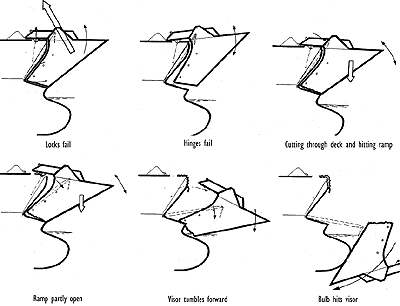 Click image for close-up
Click image for close-up
|
 |
 |
Although damage stability requirements concern only the watertight part of a vessel below the bulkhead deck, a large stability reserve remains in the superstructure as long as it remains intact. The stability manual for the ESTONIA included the hull up to deck 4 as contributing to the stability range.
 Because of the list, waves reached up to the accommodation decks, breaking doors and windows. The interior started to flood and the stability reserve disappeared. Critical openings were (see 12.6.1) large aft-located windows on decks 4 and 5, the cafeteria doors on deck 5, a weathertight door to the forecastle deck, and the ramp opening. Ventilation ducts to the car deck were installed at deck 4 level. According to testimony from a member of the alternate crew the ducts were normally closed. The ducts may, however, have opened during flooding. Because of the list, waves reached up to the accommodation decks, breaking doors and windows. The interior started to flood and the stability reserve disappeared. Critical openings were (see 12.6.1) large aft-located windows on decks 4 and 5, the cafeteria doors on deck 5, a weathertight door to the forecastle deck, and the ramp opening. Ventilation ducts to the car deck were installed at deck 4 level. According to testimony from a member of the alternate crew the ducts were normally closed. The ducts may, however, have opened during flooding.
 The first potential openings to be submerged were the aft windows on deck 4. In calm water this would have happened when about 2,000 tons of water, or about 70 cm evenly distributed had entered the car deck and caused a heel angle of about 40 degrees. Waves with considerable impact energy would have pounded against these windows earlier. It is unlikely that the windows, although of heavy construction, withstood such impact forces. The first windows broke probably a little after the main engines had stopped and when the vessel was drifting with her starboard side to the waves. Quickly submerged were also the aft windows and the aft door on deck 5. This happened at a list of about 50 degrees, which is supported by an observation from a witness in the Cafeteria on deck 5. The first potential openings to be submerged were the aft windows on deck 4. In calm water this would have happened when about 2,000 tons of water, or about 70 cm evenly distributed had entered the car deck and caused a heel angle of about 40 degrees. Waves with considerable impact energy would have pounded against these windows earlier. It is unlikely that the windows, although of heavy construction, withstood such impact forces. The first windows broke probably a little after the main engines had stopped and when the vessel was drifting with her starboard side to the waves. Quickly submerged were also the aft windows and the aft door on deck 5. This happened at a list of about 50 degrees, which is supported by an observation from a witness in the Cafeteria on deck 5.
 When some of the large windows on decks 4 and 5 broke, these decks became subject to progressive flooding and no buoyancy or stability contribution was available from this part of the superstructure. List and trim to stern increased and the flow rate through the openings accelerated. As soon as the accommodation spaces started flooding, the flooding could not stop before the vessel sank, or the condition could no longer remain stable as there were connections between different decks via staircases and other openings. The watertight compartments below the car deck were thus flooded from above. When some of the large windows on decks 4 and 5 broke, these decks became subject to progressive flooding and no buoyancy or stability contribution was available from this part of the superstructure. List and trim to stern increased and the flow rate through the openings accelerated. As soon as the accommodation spaces started flooding, the flooding could not stop before the vessel sank, or the condition could no longer remain stable as there were connections between different decks via staircases and other openings. The watertight compartments below the car deck were thus flooded from above.
 The speed of flooding, however, depended on the size of the openings to the sea and on the escape of air from inside the hull regarding which there are several witness observations. Calculations indicate - as an example - that 18,000 tons of water on board, distributed between the car deck and decks 4 and 5, would have given a heel angle of about 75 degrees. This amount of water had entered the vessel in about 15 minutes, indicating an average flow rate of 20 tons per second. This is feasible through openings which have a total area of 5 - 10 m2. Progressive flooding was under way to several decks and compartments at the same time as the upper decks gradually sank under the mean water level. The speed of flooding, however, depended on the size of the openings to the sea and on the escape of air from inside the hull regarding which there are several witness observations. Calculations indicate - as an example - that 18,000 tons of water on board, distributed between the car deck and decks 4 and 5, would have given a heel angle of about 75 degrees. This amount of water had entered the vessel in about 15 minutes, indicating an average flow rate of 20 tons per second. This is feasible through openings which have a total area of 5 - 10 m2. Progressive flooding was under way to several decks and compartments at the same time as the upper decks gradually sank under the mean water level.
 If the windows and doors had remained unbroken the vessel may have remained in a stable heel condition for some time. It is, however, less likely that any reasonable strength of the large windows would have been adequate to withstand the wave impact forces. If the windows and doors had remained unbroken the vessel may have remained in a stable heel condition for some time. It is, however, less likely that any reasonable strength of the large windows would have been adequate to withstand the wave impact forces.
 It can be concluded that, although the vessel fulfilled the SOLAS damage stability requirements valid for its building period, she had no possibilities to withstand progressive flooding through the superstructure openings once the heel angle approached 40°. When windows on the accommodation decks were broken by wave forces, subsequent sinking was inevitable. It can be concluded that, although the vessel fulfilled the SOLAS damage stability requirements valid for its building period, she had no possibilities to withstand progressive flooding through the superstructure openings once the heel angle approached 40°. When windows on the accommodation decks were broken by wave forces, subsequent sinking was inevitable. |
 |

